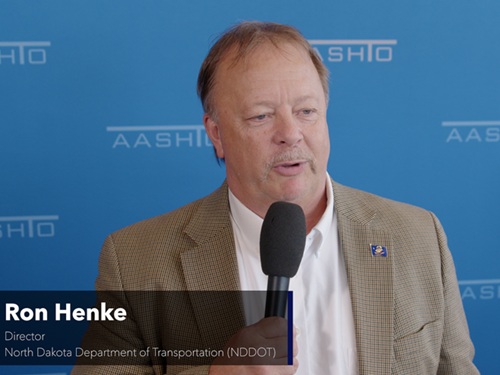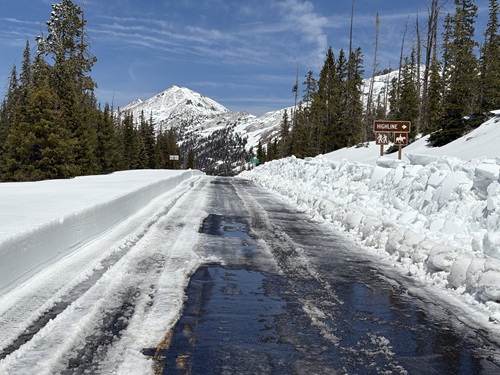In testimony at a hearing held by the Senate Committee on Environment and Public Works, Shailen Bhatt – administrator of the Federal Highway Administration – stressed that the money flowing from the Infrastructure Investment and Jobs Act or IIJA represents “more than just numbers; these dollars mean projects that will improve both safety and people’s lives.”
[Above photo via FHWA]
In his remarks to the committee, Bhatt said FHWA has “distributed more than $120 billion in highway formula funding to states, including funding for bridges, electric vehicles, and to make our infrastructure more resilient to climate change.”
He emphasized that funding includes money for programs like the Highway Safety Improvement Program, which is designed to achieve a significant reduction in traffic fatalities and serious injuries for all road users on all public roads – including non-state-owned roads and roads on tribal lands.
“That Highway Safety Improvement Program funding supported more than 5,300 projects, improving 4,515 intersections and 69,075 miles of roadway,” Bhatt noted – a critical part of the U.S. Department of Transportation’s effort to reduce roadway fatalities and injuries.
“The FHWA is actively implementing the USDOT National Roadway Safety Strategy and is committed to applying the Safe System Approach to reach our goal of zero roadway deaths and serious injuries,” he said.
“In addition to our commitment to safety, our work is guided by an initiative we refer to as ‘DRIVEN for the 21st Century.’ There are six aspects to this initiative: Delivery, Resilience, Innovation, Values, Equity, and our Nation,” he explained. “This initiative will help the FHWA accomplish USDOT’s goal of delivering results and our work across three major areas of effort: Building good things well; running our operations well in the agency; and protecting the safety and wellbeing of everyone who interacts with our transportation system.”
Bhatt noted, however, that ultimate success of IIJA as well as the Inflation Reduction Act funded programs depend, in part, on streamlined delivery of funding to recipients along with other forms of federal support.
“To be responsive to the significant changes and opportunities afforded by these laws, the FHWA stood up a new, permanent team to oversee internal crosscutting grants-management matters that affect tracking, training, outreach, and more; we also implemented process reforms across our suite of Federal grant programs,” he explained.
“We continue to refine our management of these programs to increase efficiency and transparency, thereby benefitting the nation via the delivery of new projects,” he added.
In terms of providing federal-level support to help states, tribes, and localities maximize the value of current transportation funding levels, Bhatt focused on several key actions being undertaken by FHWA:
- Technical assistance: “FHWA has specific efforts in place to provide training and technical assistance for local and rural road agencies through the Local Technical Assistance Program (LTAP), and for Tribal communities through seven new Tribal Technical Assistance Program (TTAP) centers,” he said. To support potential applicants for other funding opportunities, FHWA is also hosting informational webinars for newly published notices of funding opportunities or NOFOs.
- Resilience: Bhatt said resilience is “an important part of building a modern transportation system” as it gets people where they need to go, gets them there safely, and with less impact on the environment. He said the IIJA “offers new tools to make our infrastructure more resilient and to reduce greenhouse gas emissions from America’s transportation network” as well as reach the Biden administration’s goal of net-zero emissions by 2050.
- Innovation: Bhatt noted innovation is “essential” for the future of transportation infrastructure as “it will help us tackle a broad range of issues, such as improving safety, increasing the resilience of our transportation infrastructure, and finding new ways to combat the climate crisis.” He pointed to the FHWA Turner Fairbank Highway Research Center, as well as his agency’s support for the University Transportation Centers program, to keep research and technology innovation at high speed. “Innovation will allow us to integrate other modes of transportation into our roadway system, supporting not only private and commercial vehicles, but also pedestrians, cyclists, transit users, and people who use mobility-on-demand technologies,” he said. “While we have engineered increased safety into our infrastructure and vehicles, it is critical that we harness technology to help realize our goal of zero fatalities on U.S. roads.”
- Equity: “We have the ability to reduce inequities in and around our transportation system by expanding affordable access to transportation and related jobs, removing barriers that might prevent individuals or communities from accessing transportation, encouraging wealth creation, empowering communities, and ensuring that equity considerations for disadvantaged and underserved communities are integrated into the planning, development, and implementation of all transportation investments,” Bhatt noted. “Transportation should be done with people, not to them. The FHWA understands that we should ensure that we are listening to communities and taking their needs and desires into account.”
 Nation
Nation
North Dakota DOT Profiled in State DOT Update
July 3, 2025 Nation
Nation

